 In this article, we mainly introduce the basic situation of the Australian market. Including: geographic location, major cities, population conditions, ethnic groups, major festivals, natural resources, major industries, infrastructure construction, GDP, foreign exchange reserves, employment, prices, corporate income tax, personal tax rates, etc.
In this article, we mainly introduce the basic situation of the Australian market. Including: geographic location, major cities, population conditions, ethnic groups, major festivals, natural resources, major industries, infrastructure construction, GDP, foreign exchange reserves, employment, prices, corporate income tax, personal tax rates, etc.
Introduction
The Commonwealth of Australia (English: Commonwealth of Australia), referred to as "Australia" (Australia), has a territorial area of 7,692,024 square kilometers. It is located between the South Pacific and the Indian Ocean and is surrounded by sea. It is the only country in the world that covers an entire continent. Also called "Australia". Australia, with many unique flora and fauna and natural landscapes, is a multicultural country of immigrants.
Australia is a highly developed capitalist country. As the most economically developed country in the southern hemisphere, the world’s 12th largest economy, and the world’s fourth largest exporter of agricultural products, Australia is also the world’s largest exporter of various minerals, so it is called "The country sitting on the minecart". At the same time, Australia is also the country that raises the number of sheep and exports the most wool in the world, and is also known as the "country on the back of the sheep". Australia actively participates in international affairs and is a founding member of APEC. It is also a member of the United Nations, the G20, the Commonwealth, the Organization for Economic Cooperation and Development, and the Pacific Islands Forum.
Capital
Canberra, the capital of the Commonwealth of Australia, is located in an open valley in the mountains of southeastern Australia. It has an area of 2,395 square kilometers, a population of 410,300, and an altitude of 760 meters. The Morangelo River traverses the city and flows into the Malambiji River in the west. It was originally a sheep-grazing land. It was built as planned in 1913, and the federal government moved here from Melbourne in 1927. The national political center, with banks, restaurants and public services as the main economic sectors, and railways connecting major cities.
Main City
1.Sydney
Sydney, located on the southeastern coast of Australia, is the capital of New South Wales, Australia, and the largest and most populous city in Australia. The metropolitan area of Greater Sydney is approximately 12,368.193 square kilometers, and the urban area of Sydney is approximately 1,687 square kilometers.
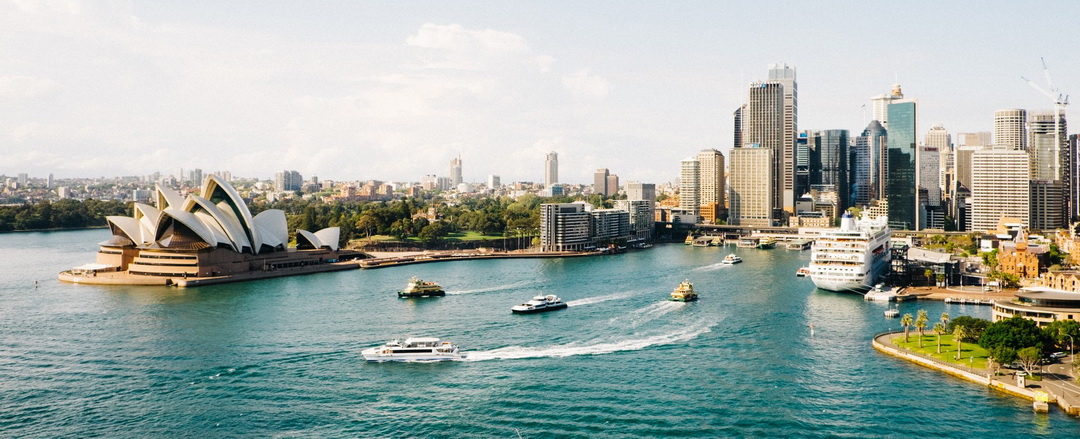 Sydney - Photo | Google
2.Melbourne
Sydney - Photo | Google
2.Melbourne
Melbourne, a coastal city in southern Australia, is the second largest city with an area of 8,831 square kilometers. Melbourne is the capital of Victoria, a world-famous tourist city, and a world-famous international metropolis. Melbourne is the cultural and industrial center of Australia, named in honor of British Prime Minister William Lamb, the second generation of Melbourne Viscount.
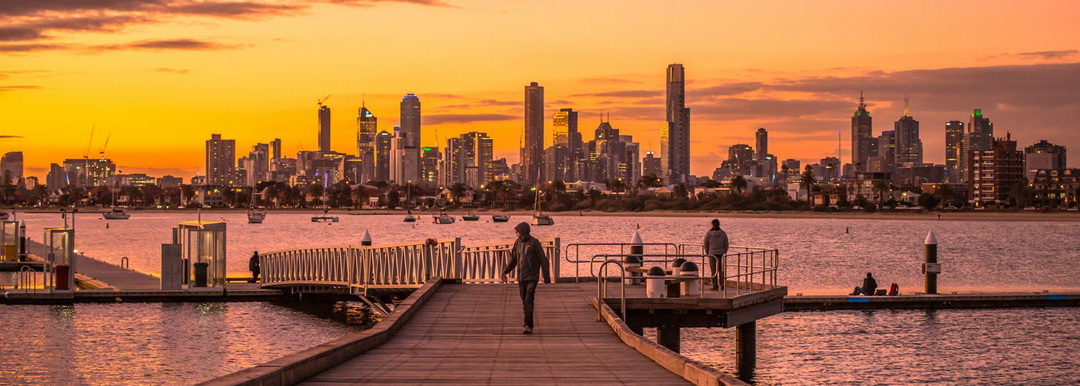 Melbourne - Photo | Google
3.Perth
Melbourne - Photo | Google
3.Perth
Perth is the capital of Western Australia and the fourth largest city in Australia. It covers an area of 5386 square kilometers, with the vast Indian Ocean to the west and 7,350 kilometers west of the latitude to reach the coast of Africa; to the east is the inland area of Australia.
4. Adelaide
Adelaide is a port city in southern Australia and the capital of South Australia. It is located on the coastal plain between the Lofty Mountains in the southeastern part of the state and the Gulf of St. Vincent, bordering the Torun River. The port is 12 kilometers northwest of the city and is connected by railway.
 Adelaide - Photo | Google
5. Hobart
Adelaide - Photo | Google
5. Hobart
Hobart, the capital and largest port city of the Australian state of Tasmania, is located at the mouth of the Derwent River in the southeast of Tasmania, covering an area of approximately 1,700 square kilometers. Hobart was founded in 1803 and is the second oldest city in Australia after Sydney.
Jet Lag
Western time is the same as China's Beijing time. Central time is one and a half hours faster than Western time. Eastern time is two hours ahead of Western time.
For example: when China is 8:00 in the morning, Australia has three times, namely: 10:00 in the morning Eastern time, 9:30 in the morning Central time, and 8:00 in the morning Western time.
Population and Ethnicity
Australia is a typical country of immigrants. In the 2006 census, whites accounted for 92%. The ancestors of most Australians were British immigrants in the 19th and 20th centuries, and many came from other countries. 37.13% call themselves Australians, followed by 31.65% of English Australians, 9.08% Irish Australians, 7.56% Scottish Australians, Italian Australians 4.29%, German Australians 4.09%, Chinese 3.37 % And Greek 1.84%.
Language
Official Language is English. Most of the nationals also speak English, and some immigrants speak some other languages.
Main Holiday
January 1st: The New Year;
January 27th: National Day, to commemorate the founding day of white people entering Australia;
March 28th-March 31st: Easter, starting from Good Friday on the 28th, a duration of 4 days;
April 17th: Good Friday;
April 25th: Anzac Day, to commemorate the landing of the Australian and New Zealand coalition forces on the Kalipoli Peninsula in Turkey by the British during the First World War.
June 9th: Queen Elizabeth's birthday, Queen Elizabeth's birthday. The holiday is set on the second Monday of June for consecutive holidays. Only Western Australia is September 29.
On the first Tuesday of November: the world-famous Australian horse racing-Melbourne Cup Grand Prix is held.
December 25th: Christmas
December 26th: Box Opening Festival, the day to open the gift boxes presented at Christmas, became the "Announcement Festival" in South Australia.
Among the other national festivals in Australia, two festivals have received special attention. One is "Enshak Day" on April 25th, which is the Australian Military Day; the other is the first Tuesday of November, which is world-renowned. Australian horse racing-the day of the Melbourne Cup Grand Prix. The city of Melbourne, the birthplace of national horse racing, will list this day as a public holiday. At that time, other parts of the country will also stop working for horse watching competitions.

Australian Horse Racing - Photo | Google
Natural Resources
There are at least 70 kinds of mineral resources. Among them, the proven economic reserves of lead, nickel, silver, uranium, zinc, and tantalum rank first in the world. Australia is the world's largest producer of lithium and zirconium, and the output of gold, iron ore, coal, lithium, manganese ore, nickel, silver, uranium, and zinc is also among the world's top. Australia is also the world's largest exporter of bituminous coal, bauxite, diamonds, and zinc concentrates, the second largest exporter of alumina, iron ore, and uranium ore, and the third largest exporter of aluminum and gold.
The fishery resources are rich. The fishing area is 16% larger than the land area. It is the third largest fishing area in the world. There are more than 3,000 kinds of seawater and freshwater fish and more than 3,000 kinds of crustacean and mollusc aquatic products, of which commercial fishing has been carried out. About 600 species. The main aquatic products are prawns, lobsters, abalones, tuna, scallops, oysters, etc.
Major Industries
Industry
Mainly in manufacturing, construction and mining. In the 2017/2018 fiscal year, the output value of Australia’s mining industry was 138.12 billion Australian dollars, accounting for 7.6% of GDP; the added value of the construction industry was A$141.04 billion, accounting for 7.8% of GDP; the manufacturing industry’s added value was A$105.17 billion, accounting for 5.8% of GDP.
Agriculture
Agriculture and animal husbandry are developed and occupy an important position in the national economy. It is the world's largest exporter of wool and beef. In the 2017/2018 fiscal year, the output value of Australian agriculture and animal husbandry was 59 billion Australian dollars, a year-on-year decrease of 3.0%. The main crops are wheat, barley, cotton, sorghum, etc. The main livestock products are beef, milk, mutton, wool, poultry, etc.
Service Industry
The service industry is the most important and fastest growing sector of the Australian economy. After more than 30 years of economic restructuring, it has become a pillar industry of the national economy. In the 2017/2018 fiscal year, the output value of the service industry was 1.45 trillion Australian dollars, accounting for 76% of Australia's GDP. The five industries with the highest output value in the service industry were finance and insurance, medical and community services, professional technology services, and public management. And security services, education and training services. Australia is one of the largest and most developed financial services markets in the Asia-Pacific region. In the 2017/2018 fiscal year, the financial industry output value was 1,583.61 Australian dollars, and the financial services industry contributed approximately 8.8% to Australia's GDP. In the 2017/2018 fiscal year, Australia's service trade exports totaled 88 billion Australian dollars.
Tourism
In the 2017/2018 fiscal year, the output value of Australia's tourism industry was A$57.3 billion, accounting for 3.1% of GDP in the same period. In recent years, the number of overseas tourists has been on the rise, but domestic tourists are still the main force in the tourism industry. In the 2017/2018 fiscal year, domestic tourists spent A$88.90 billion and overseas tourists spent A$42.50 billion in Australia. Rich in tourism resources, famous tourist cities and attractions include Sydney, Melbourne, Brisbane, Adelaide, Perth, Gold Coast, Darwin, Great Barrier Reef, Ayers Rock (Uluru), etc. Since the outbreak of the new crown pneumonia in 2020, Australia's tourism industry has been severely impacted. According to Australian statistics, the number of international tourists in the 2019/2020 fiscal year dropped by 27.9%. From January to May 2020, Australia's tourism industry lost 23 billion Australian dollars.
Infrastructure
Australia has developed international sea and air transportation industries. Sydney is a major transportation hub in the South Pacific.
Railway
Since the 1990s, the railway industry has undergone corporatization and privatization reforms. The total length of national railways is about 44,000 kilometers. In 2009/2010, there were approximately 15 million long-distance railway passengers and approximately 603 million urban rail transit passengers, basically the same as the previous year. In 2006/2007, the railway transported 665 million tons of cargo, a year-on-year increase of 3.8%.
Highway
The total length of national highways exceeds 800,000 kilometers. In 2012, 16.7 million motor vehicles were registered, including 12.71 million passenger cars, 2.61 million light trucks, and 90,000 buses.
Water Transport
With 97 ports, Melbourne is the country's largest port. In 2011/2012, there were about 80 international shipping vessels, with a volume of 899 million tons of international shipping, and 30,541 vessels arriving in Hong Kong each time.
Air Transport
The top ten airports in passenger traffic are: Sydney, Melbourne, Brisbane, Perth, Adelaide, Gold Coast, Cairns, Canberra, Hobart and Darwin.
Economic recovery was interrupted
For the entire year of 2019, Australia’s entire society completed a nominal GDP of 1994.874 billion Australian dollars, which was close to 1.4 trillion US dollars (specifically, 138.66 billion US dollars) based on the average exchange rate of the year, ranking 14th in the world, with an actual growth rate of 1.9%.
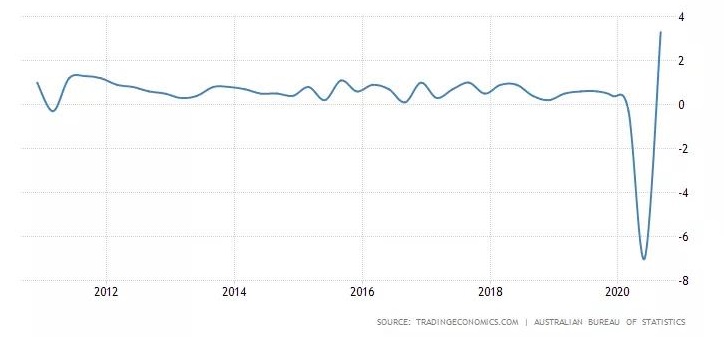 Australia's GDP growth rate trend graph over the years | TRADING ECONOMICS
Australia's GDP growth rate trend graph over the years | TRADING ECONOMICS
The Australian Bureau of Statistics (ABS) announced the third quarter GDP data on December 2. The country's gross domestic product (GDP) increased by 3.3% in the third quarter of this year, and the total GDP for the whole year of 2020 decreased by 3.8%. . Some experts believe that Australia's GDP will shrink by 6% this year in a "trade war" with China.
Foreign exchange reserves fell sharply
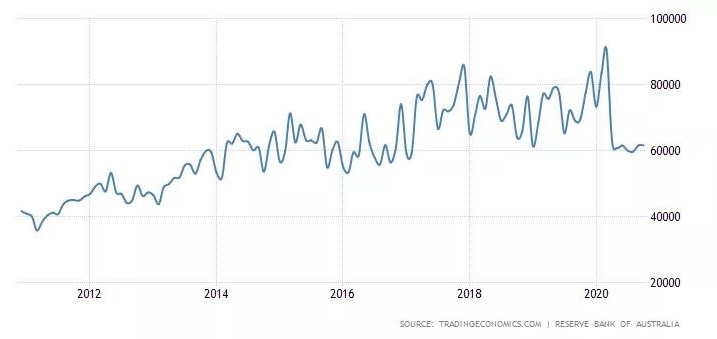 Australia's foreign exchange reserves trend over the years | TRADING ECONOMICS
Australia's foreign exchange reserves trend over the years | TRADING ECONOMICS
Australia's foreign exchange reserves have fluctuated frequently in recent years, and in 2020 it will drop sharply.
Unemployment rate returns to high
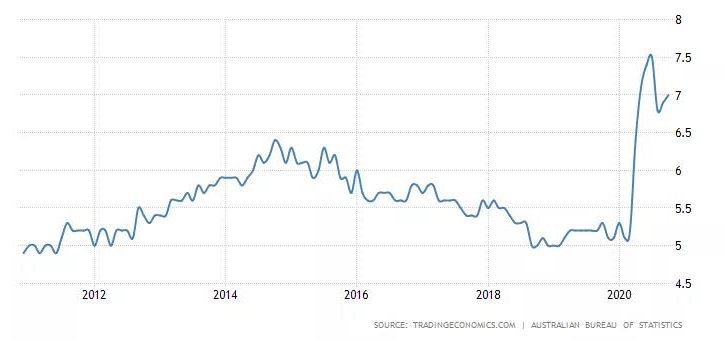 Australia's unemployment rate trend chart over the years | TRADING ECONOMICS
Australia's unemployment rate trend chart over the years | TRADING ECONOMICS
The Australian economy is deteriorating, and with it comes the problem of increasing unemployment. According to statistics, as of October, 960,000 people have lost their jobs in Australia, and it is expected that this number will increase to 1.7 million by 2021.
2.7 million is not a small number. Australia has a total population of 25.364 million, and the number of unemployed accounts for 7% of the total population.
Prices have continued to rise in recent years, and the inflation rate has remained low
 Australia Consumer Price Index CPI Trends over the Years | TRADING ECONOMICS
Australia Consumer Price Index CPI Trends over the Years | TRADING ECONOMICS
From 2016 to 2020, the growth of the Australian consumer price index CPI accelerated, and prices continued to rise.
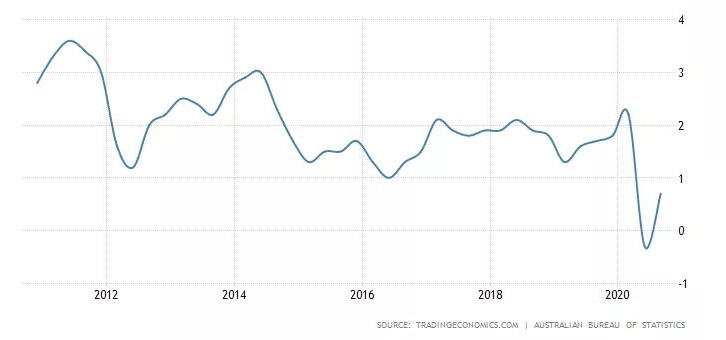 Australia's inflation rate trend chart over the years | TRADING ECONOMICS
Australia's inflation rate trend chart over the years | TRADING ECONOMICS
From 2011 to 2020, Australia's inflation rate remained low for a long time, and once fell to a negative number in 2020, the economic growth rate dropped significantly.
Corporate income tax 30%
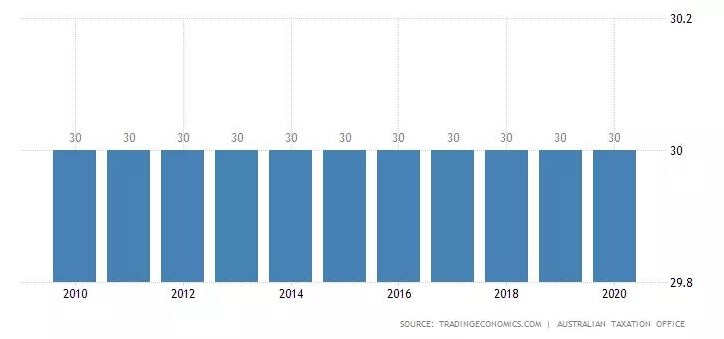 Australia's corporate income tax trends over the years | TRADING ECONOMICS
Australia's corporate income tax trends over the years | TRADING ECONOMICS
In 2020, the Australian corporate income tax rate is 30%.
Personal income tax 45%
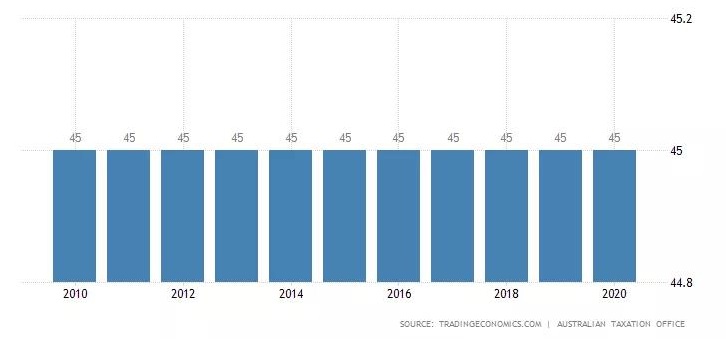 Australia's personal income tax trends over the years | TRADING ECONOMICS
Australia's personal income tax trends over the years | TRADING ECONOMICS
In 2020, the Australian personal income tax rate is 45%.
www.bozhou-int.com












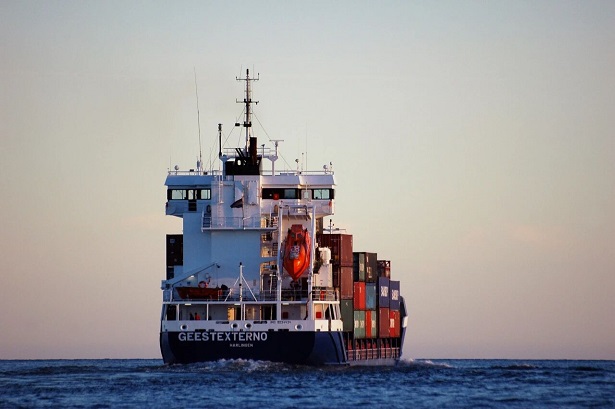 China's Import and Export Data
China's Import and Export Data
 Latest Progress of China-Europe Freight Trains
Latest Progress of China-Europe Freight Trains
 2025 Chinese military parade
2025 Chinese military parade